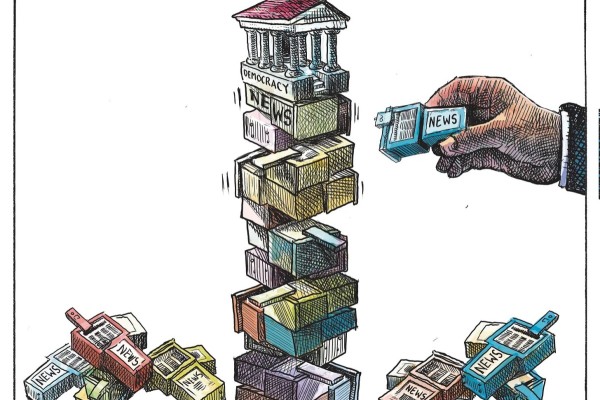New report shows ‘news deprivation’ rampant across Canada
A bigger problem is “truth deprivation” from mountains of self-serving media propaganda

According to a new report by the CCPA, almost 2.5 million Canadians live in a postal code with one or no local news outlet, twice the proportion in 2008. Photo by Jon S/Flickr.
It may take decades to dig ourselves out from under the mountain of misinformation, disinformation and plain old BS offered up by Canada’s newspaper industry and its enablers in pursuit of the hundreds of millions in federal bailout money, tax credits and forced subsidies it has pocketed in the past few years. If we can ever spot the truth through so much propaganda, that is. The federal government’s stated rationale for introducing the Online News Act in 2022, which aimed to force Google and Meta to pay Canadian newspapers hundreds of millions a year for linking to their news stories, included that “more than 450 news outlets have closed since 2008.” The number came from data provided by the Local News Research Project (LNRP) at Toronto Metropolitan University, and like Pinocchio’s nose it just keeps growing and growing. By last fall, the number had grown to 525 local news outlets closed in 347 communities across Canada since 2008, according to a LNRP report tabled in the Senate.
These figures would be alarming if accurate, as Canada’s newspaper industry in 2011 included just over 1,000 community newspapers and about 100 dailies. What is truly alarming is how LNRP data diverge so markedly from the annual inventory taken until recently by industry association News Media Canada. The LNRP first came to notice in 2017, when a think tank report cited its data and claimed that 225 weekly and 27 daily newspapers had been lost to closure or merger in more than 210 federal ridings since 2010. The Public Policy Forum’s report The Shattered Mirror was influential in the $595 million news media bailout announced the following year. A federal Department of Heritage report published later in 2017, however, plotted NMC data and instead concluded that the number of community newspapers had “remained steady.” The number of dailies has undeniably dropped sharply, mostly because about two dozen free commuter tabloids have closed for lack of advertising, and partly because some dailies have dropped a publication day, usually Mondays. A spate of closures during the pandemic cut the number of community newspapers from 1,026 in 2019 to 974 in 2020, and the number fell slightly to about 950 over the next two years. NMC has not updated its inventory since 2022.
Now a new study confirms that the state of local news coverage is dire, which was already evident from every anecdotal and statistical indicator, but not as dire as the LNRP has been claiming. “The rate of local news deprivation across Canada is snowballing,” noted the report published last week by the Canadian Centre for Policy Alternatives. “The commercial media model that has been dominant in Canada for more than a century is no longer viable. Despite efforts by the federal government to provide financial and regulatory supports for this model, its demise is accelerating. The solution cannot be to shut the lights and lock the door on local news and public affairs.” The report co-authored by CCPA Senior Economist David Macdonald and Sonja Macdonald (no relation) found that almost 2.5 million Canadians live in a postal code with one or no local news outlet, twice the proportion in 2008. The number of private broadcasting outlets in radio and TV has shrunk by nine percent since 2008, they added, with last year being the worst on record due to a net loss of 14.5 outlets driven by closures by CTV and Corus. “Some of the biggest declines in smaller communities have been cataclysmic,” their report noted. “Newfoundland and Labrador tops the charts with a loss of 73 per cent of their news sources in the past 16 years… Only Ontario recorded an increase in print outlets since 2008 in its smaller communities. All provinces or territories reported a decrease in print outlets in smaller communities outside of the big cities.” The researchers also created a searchable online “news deprivation index” for the 45 cities in Canada of more than 140,000 in population and all capital cities.
The report notes that 2023 was a particularly bad year for local news with the closure of 83 newspapers due to the bankruptcies of Metroland in Ontario and Métro Média in Québec. These two examples point up the real problem with news media in Canada, which is not the dominance of online advertising by Google and Facebook, as they claim, but instead corporate plundering. Metroland is the community newspaper division of Torstar, which also publishes the country’s largest daily, the Toronto Star, and was taken over for a bargain price during the pandemic by private equity firm NordStar Capital. It has been profitably piecing off the company ever since, soon floating Torstar’s digital division Verticalscope on the stock market for more than twice what it had paid for the entire company. It then laid off 605 Metroland workers in converting its 70 community newspapers to online-only publication, audaciously cheating them out of most of the severance pay they were owed by claiming creditor protection in court because it was deeply in debt. Torstar absurdly retained ownership of Metroland because it was somehow Metroland’s largest creditor. Métro Média declared bankruptcy after the group’s owner looted the company of $2.57 million 2021 after it had received millions in government assistance.
The country’s largest newspaper company, Postmedia Network, continues to buy up smaller chains and cut their costs by laying off staff and closing editions in order to make tens of millions a year in payments on the massive debt held mostly by its US hedge fund owners. It took over the SaltWire Network chain in Atlantic Canada last year, which soon brought the inevitable cutbacks to editions, journalists and content. Since it is now getting so much in subsidies, including tax credits from the federal bailout, its slice of the $100 million a year Google has promised in order to comply with the Online News Act (Meta blocked news rather than pay publishers) and various provincial programs, Postmedia should now be able to continue making for the foreseeable future the more than $30 million in debt payments owed annually to its US hedge fund owners.
How the high finance wizards persuaded Ottawa to hook them up with such rich subsidies is a tale told in my 2023 book The Postmedia Effect, which chronicles their campaign for the 2019 bailout carried out by what I call the Newspaper Lobby. It was assembled by former Postmedia CEO Paul Godfrey, who then retired after making $5 million that year, including bonuses. The intense lobbying campaign included hiring a Liberal insider to personally press senior government ministers, running blank front pages on Postmedia and Torstar newspapers for a day and some wildly-inflated data offered up in The Shattered Mirror.
I queried LNRP head April Lindgren to no avail at the time on the differences between her data and NMC’s annual inventory, criticisms of her “crowdsourcing” method of data collection, and any connections between her research and The Shattered Mirror, whose author was married to the then-head of her journalism school. I wrote a 2021 paper chronicling these and other discrepancies in data offered up in support of the bailout, which was published in the peer-reviewed Canadian Journal of Communication. Lindgren responded the following year in a co-authored article published on the LNRP website that claimed the inventory and online map “measure different phenomena. The Local News Map tracks the opening and closing of community newspapers. NMC’s annual snapshot of existing community newspapers is just that—a snapshot of existing publications at a point in time.”
LNMP data are still taken as gospel by Ottawa, but it should be apparent by now that its method has served to inflate the diminution of Canada’s news media and thus serve our media overlords.
Editor’s note: A previous version of this article incorrectly characterized how open-source data is collected by the Local News Map. It also stated that the Local News Map “only records the closure of existing news media outlets and not the founding of new ones.” In fact, the Map tracks the launch of local daily and community newspapers, public and private broadcast outlets, as well as online news sources. Canadian Dimension regrets these errors.
Marc Edge teaches Media & Communication at University Canada West in Vancouver. His research on Canadian media can be found online at www.marcedge.com.










